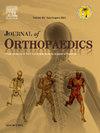The influence of CPAK classification on the pivot motion between kinematic and mechanical alignment total knee arthroplasty
IF 1.5
Q3 ORTHOPEDICS
引用次数: 0
Abstract
Purpose
This study investigated whether the preoperative coronal plane alignment of the knee (CPAK), categorized as type I or II, has an effect on postoperative tibial internal rotation (TIR) relative to the femur in patients who received a medial pivot-cruciate retaining (MP-CR) total knee arthroplasty (TKA).
Methods
We retrospectively analyzed 62 patients who underwent MP-CR TKA with the GMK Sphere implant (Medacta International, Switzerland) from January 2024 to May 2025. Based on their CPAK classification, patients were divided into two groups (type I or II). Intraoperative kinematic assessments were performed using augmented reality (AR) CT-guided navigation (NextAR, Medacta), evaluating the dynamic elongation of medial and lateral collateral ligaments during either kinematic (KA) or mechanical alignment (MA) procedures. The primary measure was TIR at 30°, 60°, 90°, and 120° of knee flexion.
Univariate analyses identified significant differences, which were further assessed using multi-way ANOVA to determine interactions with CPAK classification.
Results
Notable differences in TIR were found between CPAK types I and II at 60° (2.1° ± 4.8° vs. −2.0° ± 4.2°, p = 0.009), 90° (7.0° ± 4.3° vs. 2.1° ± 5.6°, p = 0.002), and 120° (13.1° ± 5.2° vs. 7.5° ± 4.9°, p = 0.002). Additionally, at 90°, sex and alignment method (KA vs. MA) showed significant interaction with CPAK classification (F = 6.4; p = 0.015), while the alignment method alone had no significant effect on TIR.
Conclusion
The CPAK classification prior to surgery affected TIR outcomes regardless of the alignment method used, as measured via AR-CT navigation.
CPAK分类对运动学和机械对齐全膝关节置换术间枢轴运动的影响
目的:本研究探讨了I型或II型膝关节冠状面对齐(CPAK)对接受内侧枢轴-十字交叉保留(MP-CR)全膝关节置换术(TKA)患者术后胫骨内旋(TIR)相对于股骨的影响。方法回顾性分析2024年1月至2025年5月期间接受GMK Sphere种植体MP-CR TKA治疗的62例患者。根据CPAK的分型,将患者分为I型和II型两组。术中使用增强现实(AR) ct引导导航(NextAR, Medacta)进行运动学评估,在运动学(KA)或机械对齐(MA)过程中评估内侧和外侧副韧带的动态伸长。主要测量膝关节屈曲30°、60°、90°和120°时的TIR。单因素分析发现了显著差异,进一步使用多因素方差分析来确定与CPAK分类的相互作用。ResultsNotable CPAK类型之间的不同的行动被发现I和II 60°(2.1°±4.8°与−2.0°±4.2°,p = 0.009), 90°(7.0°±4.3°和2.1°±5.6°,p = 0.002),和120°(13.1°±5.2°和7.5°±4.9°,p = 0.002)。此外,在90°时,性别和对准方法(KA vs. MA)与CPAK分类有显著的相互作用(F = 6.4;p = 0.015),而单独对准方法对TIR无显著影响。通过AR-CT导航测量,术前CPAK分类影响TIR结果,无论采用何种对准方法。
本文章由计算机程序翻译,如有差异,请以英文原文为准。
求助全文
约1分钟内获得全文
求助全文
来源期刊

Journal of orthopaedics
ORTHOPEDICS-
CiteScore
3.50
自引率
6.70%
发文量
202
审稿时长
56 days
期刊介绍:
Journal of Orthopaedics aims to be a leading journal in orthopaedics and contribute towards the improvement of quality of orthopedic health care. The journal publishes original research work and review articles related to different aspects of orthopaedics including Arthroplasty, Arthroscopy, Sports Medicine, Trauma, Spine and Spinal deformities, Pediatric orthopaedics, limb reconstruction procedures, hand surgery, and orthopaedic oncology. It also publishes articles on continuing education, health-related information, case reports and letters to the editor. It is requested to note that the journal has an international readership and all submissions should be aimed at specifying something about the setting in which the work was conducted. Authors must also provide any specific reasons for the research and also provide an elaborate description of the results.
 求助内容:
求助内容: 应助结果提醒方式:
应助结果提醒方式:


